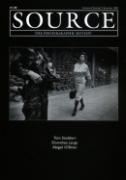Baptism
'Baptism' by Abigail O'Brien was at Temple Bar gallery, Dublin, 1996
Review by Nicholas Allen
Issue 8 Summer 1996
View Contents ▸
I'm sitting in the middle of Belfast with a helicopter blaring over my head and more than enough police to act as extras in an Irish Braveheart standing in the streets below me. I can't find a good channel on the radio so I've settled for a violin from the far end of the tuner to lament my late night in the office. In this context photographs of Baby shoes and elaborate Salt cellars in the shape of a pram do not seem like the keys to a discussion of the world's problems, a few of which are so dully paraded in front of me.
Yet if I renounce even the mundane then perhaps the extreme will take the ground from before me. Abigail O'Brien provides a relevant comment upon such a problem. She claims of her work that "What I'm trying to do is not so much make points as understand what's going on and make visible my own world... I live in a world of contradictions". This perhaps helps to explain why the element of portraiture in her work combines with a concentration upon that which is not normally reified as worthy of such treatment. Thus, a lace covered table is presented to the viewer. It is covered in cards to welcome the birth of a child. First instincts are to say 'So what?'. But something about the hyper-real texture of the image arrests. The cards read like a potted cultural history of the family unit. There is an image of Christ being bathed by a disciple, a form of baptism which in its iconic presentation suggests the pressure that expectations can bring. Behind this, a reproduction of what at first appears to be a Victorian depiction of mother and child. Looking more closely, one cannot help but notice the faded finery of the woman's shawl and the hint of exposure of a breast. Flesh is bared again by the two cherubs fondling beside this. Their bodies are fulsome and rounded with their wings cast in the most modest of proportions. Finally there is the most contemporary of images, a baby drawn to its anatomical likeness.
Yet even this is in its context shown to be transparent as the child sleeps with arms folded, the body ensconced in lacy frills. As these portraits vie within a portrait for attention, I am reminded of O'Brien suggesting that "the more you make visible problems, the greater the questions are". One begins to look for gaps in the image to signify some space in which the viewer can construct an escape, a midway through to a resolution which might satisfy in face of so much statement. But the only space available is hemmed in by the tablecloth, itself decorated by a line of crosses.
At this stage the viewer is left with only two obvious alternatives. The first is to reject the image as unsatisfactory, incomplete in its very suggestion of an absolute, linear frame of reference by which the viewer might comprehend the construction of a female identity so powerful as 'mother'. The second is to work from O'Brien's proposition that these images are "a complex series of stories for me". The 'me' is perhaps the important part. If one views the photographs as an attempt at individual resolution they become engaging in a way that a viewer who looks upon them as mere symbol might understandably miss. The possibility of autobiography brings with it the possibility of puzzle and play in those images where escape from structured representation and allegory is not formally permitted. O'Brien reflected upon this in conversation when she suggested of women's roles that "the things that are accepted are constantly in a state of flux". Such an awareness of movement saves images which might otherwise seem like excerpts from an Argos catalogue.
It should however be remembered that O'Brien is to her credit attempting to do what is almost impossible. She claims that in 'Baptism' she "wanted to make visible women's issues in a celebratory way". To do so she has chosen to try and reassimilate the culture of birth and its rituals into a less demanding, more creative canon. To O'Brien the images of the waterfall most clearly show the viewer the power that is needed to do so. Therein lies the final problem. The waterfall suggests a certain replenishment and concentration of stamina that an artist cannot always rely upon. The demands created by a state of flux are equally as challenging as its merits. In some ways then the photographs might benefit from a practice which admits the possibility of error and organises less stringently the items it presents. There is a hint that O'Brien is aware of this as she admits to taking a "long time to say 'That's a reasonable finishing point'" in her photographs. This is an important admission as all the possibility of further insight still lies before her.
Other articles by Nicholas Allen:
Issue 4: Reviewing My Insolent Ontologies - The Family Album [Review] ▸
Issue 13: Causality and Contingency - Irish Landscape Images [Review] ▸
Other articles mentioning Abigail O'Brien:






